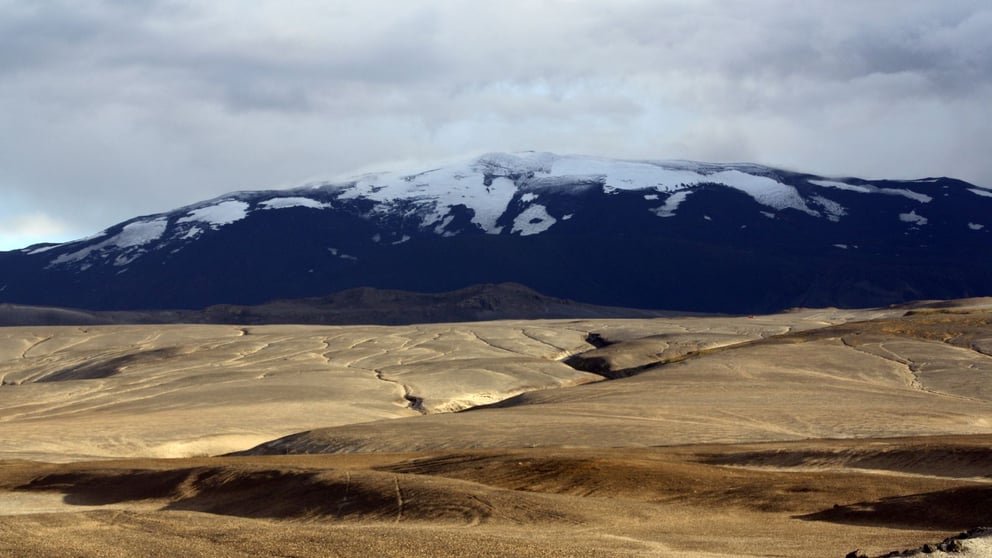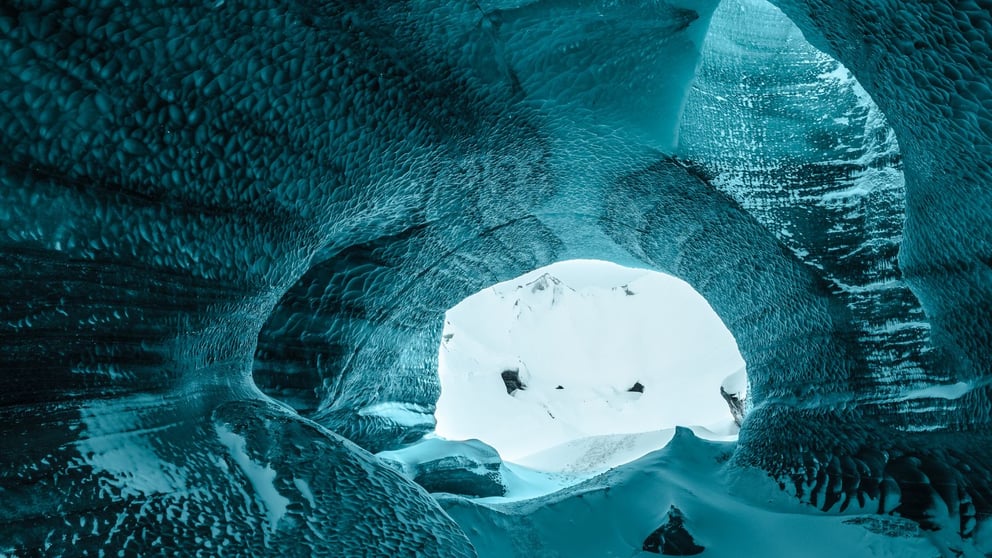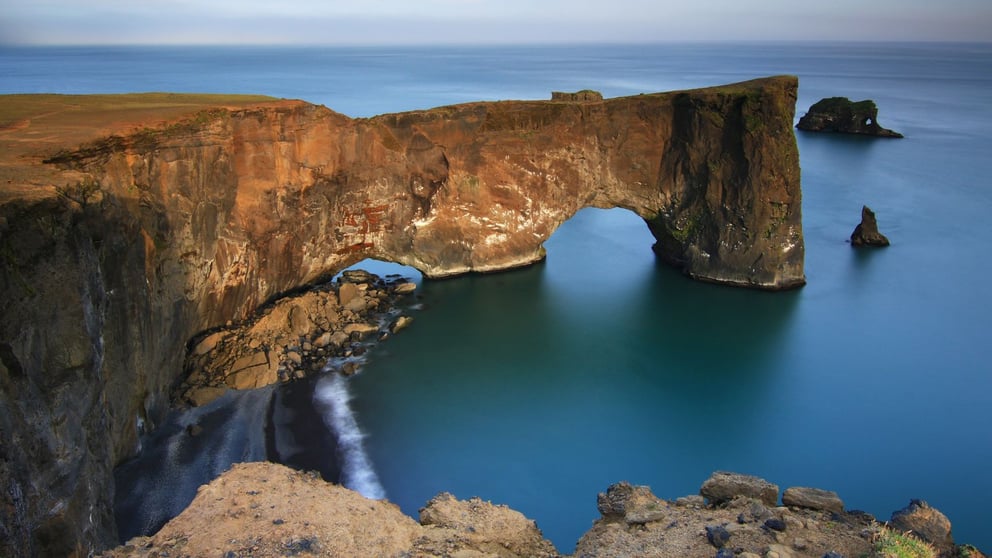Katla Volcano Travel Guide
Lurking beneath the mighty Mýrdalsjökull glacier in South Iceland is a sleeping beast. Meet one of the island’s most powerful and intriguing volcanoes, Katla. Known for its imposing size, lava-filled history, and the amazing Katla Ice Cave, this active Icelandic volcano is something all adventure-seekers visiting Iceland should plan to see!
In this guide, we’ll pull together all the answers to your questions about Katla Volcano, from how to get there, what to do, and what makes it so special. So whether you’re planning a quick stop on a South Coast road trip or looking for an all-encompassing, authentic, and in-depth Katla Volcano experience, you’ll find everything you need here.
Katla Volcano: Facts, History & Activity
Katla is one of Iceland’s most active and powerful volcanoes. It sits underneath the Mýrdalsjökull glacier and is classified as a subglacial stratovolcano. Katla is famous for its huge eruption potential, as well as the fact that any activity is lurking beneath layers of thick ice.

What Type of Volcano Is Katla?
Katla is known as a stratovolcano, which is a type of volcano that is built up over time through many layers of ash, lava, and tephra (volcanic debris) from previous eruptions. The fact that Katla is located beneath a glacier makes it unique and means that it is classed as a subglacial volcano. When Katla erupts, the combination of ice and fire can lead to what is known in Iceland as jökulhlaups: massive glacial flooding.
Is Katla Volcano Active?
Yes, Katla is considered to be an active volcano; however, it hasn’t actually seen a major eruption since 1918. Scientists monitor it closely, though, due to its potential for intense eruptions. Seismic activity in the area is strong and frequent, and experts strongly feel that Katla is overdue for an eruption, taking historical patterns into consideration.
This in no way means that it’s unsafe to visit Katla, though. Scientists are constantly monitoring the area, and any change in circumstances would be widespread news, meaning you’d know well ahead of time if you needed to avoid the area.
When Did Katla Last Erupt?
The last major eruption at Katla was in 1918, which actually extended Iceland’s coastline due to the huge amount of volcanic material that was deposited. Imagine that - an eruption so significant that it actually made Iceland bigger!
Prior to 1918, Katla erupted every 40-80 years, making this current period of stillness unusually long. Still, no imminent signs of eruption have been recorded, making it safe to visit.
Where Is Katla Volcano?
Katla Volcano is located in the South of Iceland, beneath Mýrdalsjökull glacier. It’s not far from the popular village of Vík í Mýrdal near Reynisfjara Black Sand Beach. Katla is just a short detour north of the Ring Road, making it simple to reach.
Katla is located about 105 miles (170 km) from Reykjavík and will take you about 2.5-3 hours to reach by rental car. The drive is remarkable, taking you along a route that will lead you past waterfalls, beaches, and lava fields.
Katla Volcano Map
Visitors to Iceland trying to spot Katla Volcano from the car window can sometimes be confused. You won’t see the volcano’s crater directly, since it is covered by ice. Katla’s location is marked by access points to the Katla Ice cave or nearby Mýrdalsjökull glacier. If you see these signs, you know you’re in the right place.
Coordinates (approximate):
63.63° N, 19.05° W
The Katla Ice Cave Experience

One of the most popular and unforgettable ways to experience the area is by visiting the Katla Ice Cave. This rare and stunning natural wonder is located beneath the Mýrdalsjökull glacier. As one of the only ice caves in Iceland that is accessible all year round, it’s a standout attraction for visitors in summer and winter.
Many ice caves and glacier tunnels in Iceland depend on weather conditions and the season. But Katla Ice Cave exists as a result of the volcanic and glacial interaction that occurs beneath the surface of Mýrdalsjökull. Here’s what you can experience:
- Jaw-dropping, crystal-clear, and blue ice formations
- Otherworldly textures and shapes, sculpted by geothermal activity and glacial melt patterns
- Striking black volcanic ash streaks woven through the ice
- Ever-changing scenery shaped by the power of Katla
Katla Ice Cave can only be visited as part of an organized tour. The entrance is remote and difficult to access, so you wouldn’t be able to visit on your own, and relying on professional and expert guides makes the entire experience safe and more enjoyable. Most tours depart from Vík and many include Super Jeep transport and proper gear for exploring beneath a glacier and volcano!
What to Do and See Near Katla

Exploring Katla volcano and the ice cave are just two ways to enjoy this incredible region of Iceland. If you’re coming all this way, make sure to soak up some other fantastic sights in the area.
- Vík í Mýrdal: Just a short drive from the Katla area is the charming village of Vík. It’s a great base for guided tours of the volcano, and there are plenty of places to eat, shop, and stay for a night or two.
- Reynisfjara Black Sand Beach: One of Iceland’s most famous sights is also near Katla. Enjoy dramatic scenery, volcanic sand, and stunning rock formations, but stay out of the water!
- Dyrhólaey Peninsula: Enjoy panoramic coastal views along this headland, including the famous Dyrhólaey Arch rock formation. There’s also excellent birdwatching along the cliffs, and if you visit at the right time of the year, you might spot nesting puffins!
- Skógafoss and Kvernufoss Waterfalls: If you head west from Katla, before long, you’ll reach one of Iceland’s largest and most popular waterfalls, Skógafoss. Just a short walk away from there is a hidden waterfall you can walk behind, called Kvernufoss.
Paying a visit to Katla Volcano lends an important understanding of Iceland’s volcanic roots and makes for some amazing memories. Our rental cars in Iceland are the perfect way to get out on the open road and explore the Katla region at your own pace.
Desperate to know more about Iceland’s volcanoes? Discover 10 amazing Icelandic volcano facts.

